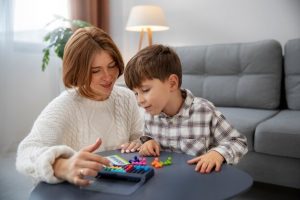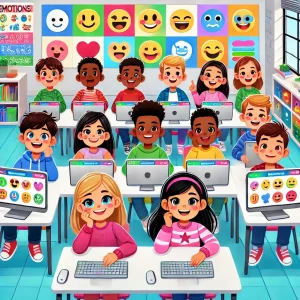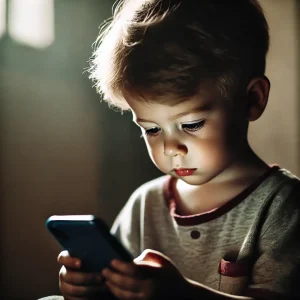Best Online Methods to Help Kids Master Emotional Regulation
Last Updated: February 7, 2025
As parents and educators, we all want to equip our children with the tools they need to navigate life’s ups and downs. One crucial skill set that often gets overlooked is emotional regulation. But what exactly is emotional regulation? Simply put, it’s the ability to manage and respond to emotions in a healthy and constructive way. For children, mastering this skill can make a world of difference in their social interactions, academic performance, and overall well-being.
In today’s digital age, teaching emotional regulation has become more accessible than ever. Thanks to technology advancements, we now have a plethora of online methods and resources at our fingertips. Whether you’re a busy parent or a dedicated teacher, these digital tools offer flexible and engaging ways to help kids understand and manage their emotions. Plus, they can be tailored to suit each child’s unique needs, making the learning process more personalized and effective.
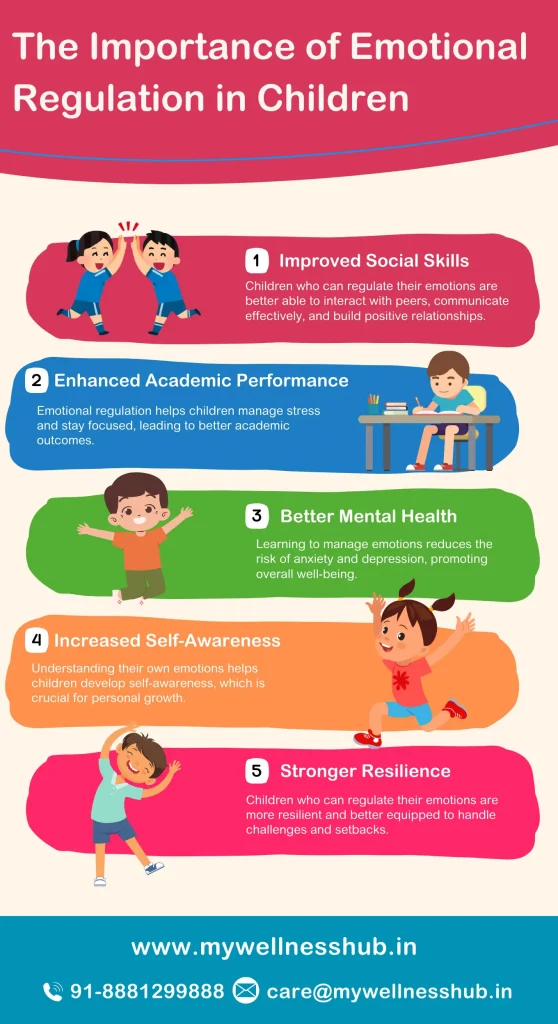
Understanding Emotional Regulation in Children
Definition and Significance of Emotional Regulation
Emotional regulation refers to the ability to recognize, understand, and manage one’s emotions in a healthy and constructive manner. For children, this skill is particularly vital as it lays the foundation for their social, academic, and personal development. When kids can effectively regulate their emotions, they are better equipped to handle challenges, build positive relationships, and achieve their goals.
In essence, emotional regulation is not about suppressing feelings but rather understanding and managing them in a way that is appropriate for the situation. It helps children navigate their emotions, whether it’s dealing with frustration during a challenging task or managing excitement in a social setting.
Key Emotional Skills Children Need to Develop
To master emotional regulation, children need to develop several key emotional skills:
- Self-Awareness: This is the ability to recognize and understand one’s own emotions. Self-awareness is the first step in emotional regulation, as it helps children identify what they are feeling and why. It also fosters a greater understanding of how their emotions affect their behavior and interactions with others.
- Impulse Control: Impulse control involves the ability to pause and think before acting. For children, this means learning to manage immediate reactions and consider the consequences of their actions. Developing impulse control helps prevent impulsive behaviors that might lead to negative outcomes, such as outbursts or conflicts.
- Empathy: Empathy is the ability to understand and share the feelings of others. It is a crucial skill for building strong, healthy relationships. When children develop empathy, they can better relate to others, offer support, and respond appropriately to social situations.
Benefits of Online Learning for Emotional Regulation
In the digital age, the benefits of online learning for emotional regulation are vast and varied. Here are some of the key advantages that make online platforms an effective tool for teaching children how to manage their emotions:
Accessibility and Convenience of Online Platforms
One of the most significant benefits of online learning is its accessibility. Regardless of where you are, online platforms provide an easy and convenient way to access educational resources. This is especially helpful for parents and educators who may not have access to specialized programs or professionals nearby. Online platforms offer a wide range of tools and resources that can be accessed at any time, making it easier for families with busy schedules to integrate emotional regulation lessons into their daily routine.
Diverse Range of Resources and Tools Available
Online platforms are rich with a variety of resources designed to teach emotional regulation. From interactive games and videos to guided exercises and virtual workshops, these resources cater to different learning styles and preferences. This diversity ensures that children can engage with the material in ways that resonate with them, making the learning process more enjoyable and effective. Additionally, the vast array of available tools means that educators and parents can find resources tailored to specific age groups and developmental stages.
Flexibility in Learning Pace and Style
Another advantage of online learning is the flexibility it offers. Unlike traditional classroom settings, online platforms allow children to learn at their own pace. This means they can spend more time on concepts they find challenging and move quickly through material they already understand. This personalized approach helps in catering to individual needs, making the learning experience more effective and less stressful.
Moreover, the flexibility of online learning extends to the style of instruction. Children can choose from various formats, such as interactive activities, video lessons, or live virtual sessions with a coach or counselor. This variety helps keep the learning process dynamic and engaging, which is crucial for maintaining interest and motivation.
Key Online Methods for Teaching Emotional Regulation
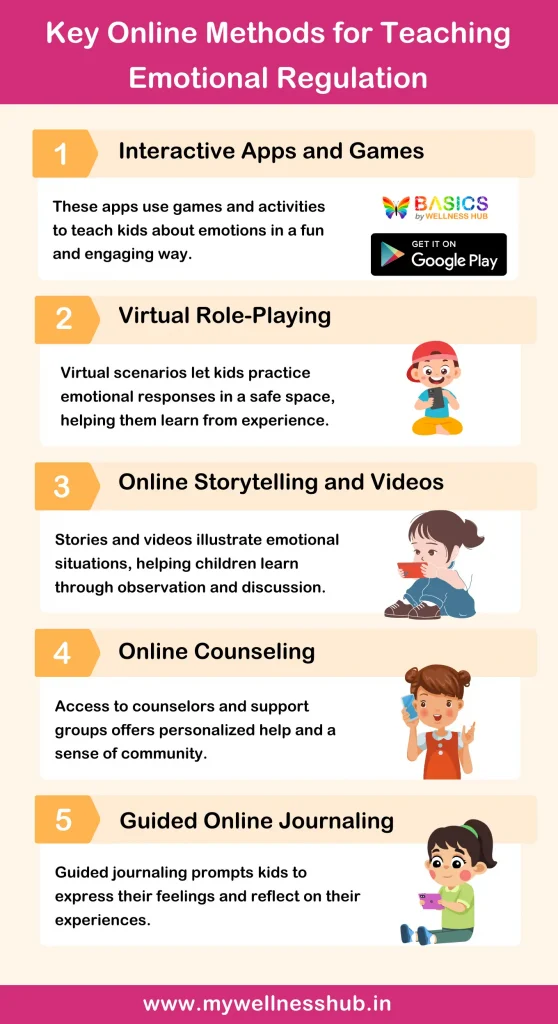
a. Interactive Apps and Games
Interactive apps and games are excellent tools for teaching children emotional regulation. These digital resources engage kids with fun and interactive experiences that help them identify and manage their emotions. Apps like ‘White Board’ enable children to practice recognizing emotions, develop coping strategies, and understand the impact of their actions on others.
The beauty of this apps is their ability to present complex emotional concepts in a simple and enjoyable format. By gamifying emotional learning, children are more likely to engage with the content and retain the lessons. For parents and educators, this app provide a valuable resource to reinforce emotional skills at home or in the classroom.
b. Virtual Role-Playing and Simulations
Virtual role-playing and simulations offer children a safe and controlled environment to practice emotional responses. These online methods involve scenarios where kids can “role-play” different situations and experiment with various ways to handle emotions. For example, a child might simulate a situation where they feel frustrated and then explore different strategies to manage that frustration, such as deep breathing or talking to a friend.
These simulations are valuable because they allow children to explore emotional responses without real-world consequences. They can experiment, make mistakes, and learn from them in a safe space. This practice helps children build confidence in their ability to manage emotions in real-life situations.
c. Online Storytelling and Videos
Storytelling and videos are powerful tools for illustrating emotional concepts. Online platforms offer a wealth of stories and animated videos that depict characters navigating various emotional challenges. Watching these stories helps children understand complex emotions and see how different characters cope with them.
After viewing, parents and educators can use discussion prompts to encourage reflection and conversation. Questions like “How did the character feel?” and “What could they have done differently?” help children think critically about emotions and develop empathy. This method not only teaches emotional concepts but also fosters a deeper understanding and connection to the material.
d. Online Counseling and Support Groups
Access to professional guidance through online counseling and support groups is another effective method for teaching emotional regulation. Platforms like Wellness Hub offer virtual counseling sessions with trained professionals who specialize in child emotional development. These counselors can provide personalized advice and support, helping children navigate their emotions in a healthy way.
Online support groups also play a crucial role. They provide a community where children can share their experiences and learn from others in similar situations. Guided conversations and feedback from peers and professionals create a supportive environment where children can feel understood and accepted.
e. Guided Online Journaling and Reflection
Guided online journaling is a fantastic way for children to express their feelings and reflect on their experiences. Platforms offering journaling prompts and digital diaries allow kids to write about their emotions, thoughts, and daily events. This practice helps children become more aware of their feelings and understand the reasons behind them.
Journaling encourages self-reflection and provides a safe outlet for emotions. Over time, it helps children recognize patterns in their emotional responses and develop strategies for managing them. It also serves as a valuable tool for parents and educators to understand a child’s emotional state and provide appropriate support.
Tips for Parents and Educators
As parents and educators, your role in supporting children’s emotional regulation is crucial. While online methods offer many advantages, they also require thoughtful guidance to ensure children get the most out of these resources. Here are some practical tips to help you navigate this journey:
Encouraging Regular Participation and Engagement in Online Activities
To maximize the benefits of online emotional regulation tools, it’s essential to encourage regular participation. Make these activities a part of your child’s daily routine, just like homework or chores. Setting a specific time for online emotional learning can help children develop a habit and see it as a natural part of their day.
Engagement is also key. Choose activities and resources that are interactive and enjoyable. Apps and games that use characters or stories that your child relates to can make learning more appealing. Encourage your child to share their thoughts and feelings about the activities, fostering open communication and a deeper connection to the material.
Monitoring Progress and Providing Additional Support as Needed
Monitoring your child’s progress in online emotional regulation lessons is vital. Regularly check in on their activities, discuss what they’ve learned, and observe any changes in their emotional responses. Some platforms provide progress tracking tools that can help you see how your child is developing their skills over time.
If you notice that your child is struggling with certain concepts or activities, don’t hesitate to provide additional support. This could mean revisiting specific lessons, seeking out new resources, or even consulting with a professional. At Wellness Hub, our expert counselors are always available to offer guidance and support, ensuring that your child receives the personalized help they need.
Balancing Screen Time with Offline Activities
While online tools are valuable, it’s essential to balance screen time with offline activities. Encourage your child to apply the skills they’re learning online in real-life situations. This could include role-playing scenarios with family members, journaling about their emotions, or engaging in creative activities like drawing or storytelling.
Offline activities help reinforce what children learn online and provide a holistic approach to emotional regulation. They also offer a break from screens, which is important for maintaining a healthy balance and preventing screen fatigue.
Also Read: How does screen time affect your child’s development?
Challenges and Considerations
While online methods for teaching emotional regulation offer numerous benefits, they also come with certain challenges and considerations. It’s important to be aware of these potential drawbacks and take steps to address them effectively.
Addressing Potential Drawbacks, Such as Screen Time and Distractions
One of the primary concerns with online learning is the amount of screen time it requires. Prolonged screen time can lead to physical strain, such as eye fatigue, and may also reduce the time available for physical activity and face-to-face interactions. To mitigate these effects, it’s crucial to set clear boundaries for screen use. Encourage regular breaks and incorporate physical activities into your child’s daily routine to balance screen time with movement and offline experiences.
Another challenge is the potential for distractions. Online platforms, while engaging, can sometimes lead to multitasking or distraction with other online content. To help children stay focused, create a dedicated learning space free from unnecessary distractions. Use parental controls if needed to limit access to unrelated websites and apps during learning sessions. Encouraging a structured schedule can also help maintain focus and create a productive learning environment.
Read more: Virtual Autism: Things that you need to know
Ensuring the Credibility and Safety of Online Resources
The internet is vast, and not all online resources are created equal. Ensuring that the tools and content used for emotional regulation are credible and safe is paramount. Look for platforms and apps that are backed by reputable organizations or developed by experts in child psychology and education. Reading reviews and seeking recommendations from trusted sources can also help in selecting high-quality resources.
Safety is another critical consideration. When using online platforms, it’s essential to protect children’s privacy and data. Choose resources that comply with privacy regulations and provide clear information about how they handle user data. For interactive platforms, ensure that there are appropriate safeguards in place, such as moderation in online forums or secure communication channels for virtual counseling.
At Wellness Hub, we prioritize the safety and well-being of your child. Our resources are carefully selected and designed to provide a safe and supportive environment for learning and growth. We encourage parents and educators to remain vigilant and proactive in selecting and using online tools for emotional regulation.
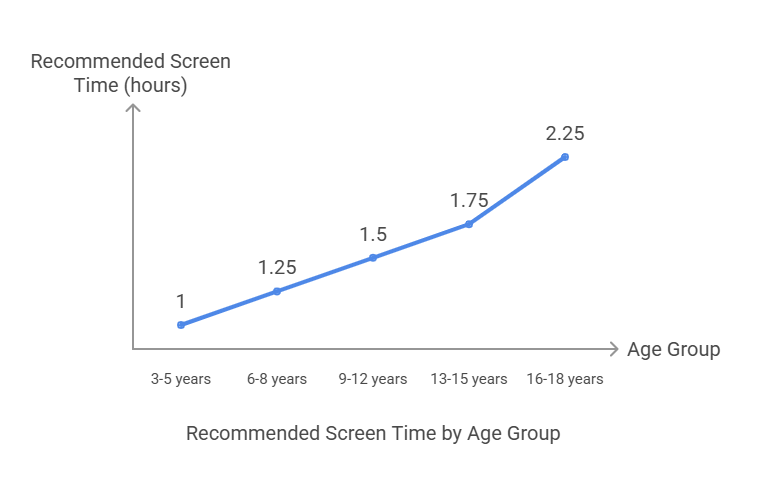
Screen Time Recommendations by Age
| Age Group | Recommended Screen Time | Suggested Offline Activities |
|---|---|---|
| 3-5 years | Up to 1 hour/day | Outdoor play, drawing, storytelling |
| 6-8 years | 1-1.5 hours/day | Creative arts and crafts, biking, nature walks |
| 9-12 years | 1-2 hours/day | Sports, reading, family games, hobbies |
| 13-15 years | 1.5-2 hours/day | Team sports, music practice, board games |
| 16-18 years | 2-2.5 hours/day | Volunteering, exercise, socializing in person |
Conclusion
Teaching emotional regulation is essential for children’s growth, helping them manage their emotions and face life’s challenges. Online methods offer a convenient and flexible way to support this learning. From fun apps and games to interactive storytelling and guided journaling, these tools make it easy for kids to understand and practice emotional regulation. They can be accessed anytime and anywhere, making them a great addition to traditional methods.
Parents and educators can use these online resources to create a positive environment for emotional learning. At Wellness Hub, we provide a variety of expert-led programs and resources to help children develop these important skills. Whether you’re looking for personalized counseling or engaging online activities, we have something to support your child’s journey. Visit our website to learn more and explore our offerings. Let’s work together to help children grow into emotionally strong and self-aware individuals.
Frequently Asked Questions:
1. What is emotional regulation in children?
Emotional regulation refers to a child’s ability to understand and manage their emotions effectively. It involves skills like recognizing emotions, controlling impulses, and responding to emotions in a healthy way.
2. Why is teaching emotional regulation important for children?
Teaching emotional regulation is crucial because it helps children develop self-awareness, build healthy relationships, and cope with life’s challenges. It lays the foundation for emotional intelligence, which is key to success in various areas of life.
3. What are the benefits of using online methods to teach emotional regulation?
Online methods offer flexibility, accessibility, and a diverse range of resources. They allow children to learn at their own pace, use engaging digital tools, and access expert guidance from the comfort of their home.
4. How can interactive apps and games help children learn emotional regulation?
Interactive apps and games are designed to make learning fun and engaging. They use relatable characters and scenarios to teach children about emotions, helping them identify and manage their feelings in a playful and effective way.
5. What are virtual role-playing and simulations, and how do they help with emotional regulation?
Virtual role-playing and simulations allow children to practice responding to various emotional situations in a controlled, safe environment. This method helps them experiment with different emotional responses and learn from their experiences without real-world consequences.
6. Can online storytelling and videos be effective for teaching emotional skills?
Yes, online storytelling and videos are effective tools for illustrating emotional concepts. They provide visual and narrative examples of how to handle different emotions, making it easier for children to understand and relate to the material.
7. How do online counseling and support groups contribute to emotional regulation?
Online counseling and support groups offer professional guidance and peer support. They provide a safe space for children to discuss their feelings, receive feedback, and learn coping strategies from experts and peers.
8. What is the role of guided online journaling in emotional regulation?
Guided online journaling helps children express their feelings and reflect on their experiences. It encourages self-awareness and provides a structured way to explore emotions, helping them understand their feelings better.
9. What challenges should parents and educators consider when using online methods for emotional regulation?
Parents and educators should be mindful of potential challenges like managing screen time and ensuring the credibility and safety of online resources. Setting clear boundaries and choosing reputable platforms are key to addressing these concerns.
10. How can I find credible and safe online resources for teaching emotional regulation?
To find credible and safe online resources, look for platforms backed by experts in child psychology and education. Reading reviews and checking for privacy compliance can also help ensure that the resources are trustworthy and secure.
About Author:
Lasya Vooturi
Clinical Psychologist (A) and Behavioral Therapist
Lasya holds a Professional Diploma in Clinical Psychology from Amity University, where she deepened her understanding of psychological principles from March 2023 to March 2024. With over a year of dedicated experience as a Behavioral Therapist, Lasya has honed her skills in applying effective therapy techniques tailored to individual needs. Fluent in Telugu, Hindi, and English, she is adept at connecting with a diverse range of clients, ensuring comprehensive communication and understanding. Lasya’s approach is grounded in empathy and scientific rigor, making her a trusted ally in navigating mental health challenges.
Book your Free Consultation Today
Parent/Caregiver Info:
Client’s Details:
* Error Message
